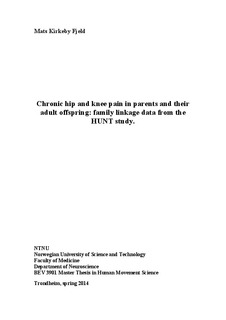| dc.contributor.advisor | Nilsen, Tom Ivar Lund | nb_NO |
| dc.contributor.advisor | Mork, Paul Jarle | nb_NO |
| dc.contributor.advisor | Lier, Ragnhild | nb_NO |
| dc.contributor.author | Fjeld, Mats Kirkeby | nb_NO |
| dc.date.accessioned | 2014-12-19T14:22:07Z | |
| dc.date.available | 2014-12-19T14:22:07Z | |
| dc.date.created | 2014-08-13 | nb_NO |
| dc.date.issued | 2014 | nb_NO |
| dc.identifier | 737521 | nb_NO |
| dc.identifier.uri | http://hdl.handle.net/11250/264301 | |
| dc.description.abstract | Background: Pain is a complex subjective sensation and is considered to be a huge global health concern. Several studies have suggested pain and chronic pain to cluster within families, but these studies have mainly focused on fibromyalgia and spinal pain. However, there is little knowledge concerning intergenerational transfer of chronic pain in knees and hips.
Objective: The purpose of this study is to investigate a possible association between parents and their adult offspring occurrence of chronic knee and hip pain, and further to examine if a potential association is stronger for subjects with higher levels of pain due to osteoarthritis.
Method: This study is based on answers from 11 080 parent-offspring trios participating in the Nord-Trøndelag Health Study (HUNT). The HUNT study includes health and lifestyle related questions - including occurrence and localization of chronic pain. Through a linkage with the Family Registry at Statistics Norway, relations between adult offspring and parents in the HUNT data were established (parental data from HUNT2 (1995-97) and offspring data from HUNT3 (2006-08)). Logistic regression analysis was used to estimate odds ratio (OR) for the association between parents and their adult offspring occurrence of chronic pain in knee and hip.
Results: Overall, 4.9% (542) of the sons and 8% (886) of the daughters reported knee pain, whereas corresponding figures for hip pain are 3.6% (398) and 9.5% (1053), respectively. The OR for chronic knee pain when mothers reported chronic knee pain was 1.8 (95% CI 1.5-2.2) in daughters and 1.3 (95% CI 1.0-1.6) in sons. When father reported knee pain the OR was 1.1 (95% CI 0.9-1.4) in daughters and 1.3 (95% CI 1.0-1.6) in sons. The OR for chronic hip pain when mothers reported chronic hip pain was 1.5 (95% CI 1.3-1.8) in daughters and 1.4 (95% CI 1.1-1.8) in sons. When fathers reported hip pain the OR was 1.4 (95%CI 1.2-1.7) in daughters and 1.5 (95% CI 1.1-1.9) in sons. If the pain was accompanied by osteoarthritis, the association was somewhat stronger in sons, compared to the association from the main analyses.
Conclusion: In this present study, the results indicate an overall increased OR for chronic knee and hip pain among adult offspring of parents reporting chronic pain in the same region. Although genetic and environmental effects cannot be separated in this study, these results suggest a heritable component in the occurrence of chronic knee and hip pain. | nb_NO |
| dc.language | eng | nb_NO |
| dc.publisher | Norges teknisk-naturvitenskapelige universitet, Det medisinske fakultet, Institutt for nevromedisin | nb_NO |
| dc.title | Chronic hip and knee pain in parents and theiradult offspring: family linkage data from the HUNT study | nb_NO |
| dc.type | Master thesis | nb_NO |
| dc.contributor.department | Norges teknisk-naturvitenskapelige universitet, Det medisinske fakultet, Institutt for nevromedisin | nb_NO |
